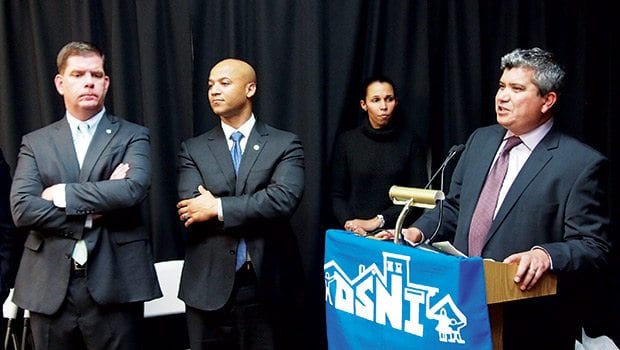
Roxbury residents registered their concerns and hopes for the future of Boston during a Dudley Street Neighborhood Initiative planning exercise last week.
During the event, which was attended by Mayor Martin Walsh and other city officials, residents visited different areas of DSNI’s office, which was organized to gather input on three topics: housing, employment and transportation.
In the housing section, residents responded to a series of questions, adding red dots to statements they agreed with. Some residents complained of evictions, others cited property tax increases and many registered their red dots in the rental increase section.
“This will tell us as an organization where we should focus our energy,” said Tony Hernandez, who is director of operations for the nonprofit’s land trust, Dudley Neighbors Incorporated. “We’re getting the pulse of the community so we can focus on the needs of the community.”
The data DSNI collects in its community visioning process will also help the city better understand the needs of the Dudley Street neighborhood, according to Sheila Dillon, director of the city’s Department of Neighborhood Development.
“A lot of the folks here might not participate directly in Boston 2030,” she said, referring to the citywide planning process the Walsh administration kicked off last year. “This is perfect timing.”
Displacement fears
For DSNI, the timing of its planning process is important not just for Boston 2030, but also because of rapidly rising rents and land values in Roxbury and Dorchester that have attracted speculators to the area where DSNI is active, which includes Dudley Street, Quincy Street and Blue Hill Avenue. In the 1980s, when vacant lots abounded in the area, DSNI was granted eminent domain powers, which allowed the agency to take vacant lots out of the speculative market and build deed-restricted affordable housing.
But as DSNI Executive Director Juan Leyton told the gathering last week, the organization still has much work to do.
“More than 30 years ago, residents formed DSNI because there was a threat of speculation and displacement of residents who have lived here for generations,” he said. “Despite all of the accomplishments we have made, this remains a threat, along with education, housing and income inequality.”
While there are only a handful of vacant lots remaining in the DSNI catchment area, there are many in the streets beyond. Hernandez says the agency may move beyond its borders to add more lots to its land trust.
“For this neighborhood, affordability is a must,” he said.
Because 80 percent of the residents in the DSNI area are renters, many of them are feeling the pressures of the housing market. Many of those renters have been turning to DSNI for help, says board member Maribel Quinones.
“You see new housing being built, and it’s not affordable,” she said. “Residents aren’t benefitting from the new development.”
Boston 2030
DSNI is the second neighborhood organization seeking to append its own planning process to the Boston 2030 effort. In Chinatown, the Chinese Progressive Association also has held planning events and completed its own neighborhood master plan.
Across the city, Boston Redevelopment Authority officials hope to stitch together individual plans, like the process the agency has launched along Washington Street and Columbus Avenue in Jamaica Plain and Roxbury, and those it plans to launch in Dudley Square, South Boston and the Freeport Street area in Dorchester.
Walsh said DSNI’s move to take the lead on planning in its catchment area is in keeping with Boston 2030’s goal of fostering community participation in city planning.
“That’s really the intention,” he said. “It’s to get DSNI and other neighborhood organizations discussing what the future of the city should be. This is probably the best I’ve seen, so far, of an organization doing something on Boston 2030. They have boards, charts, numbers, suggestions, they have young children talking about this. That’s the way it should be.”
Other local officials who attended DSNI’s event included Boston Chief of Education Rahn Dorsey, Chief of Economic Development John Barros, Rep. Evandro Carvalho and Councilor Tito Jackson.
“DSNI is doing what it has always been doing, which is community engagement,” said Rep. Carvalho. “Looking forward, I want to work with DSNI to make sure we continue to build and develop the community, and increase opportunities for people that are here today.”


![Banner [Virtual] Art Gallery](https://baystatebanner.com/wp-content/uploads/2024/04/Cagen-Luse_Men-at-store-e1713991226112-150x150.jpg)



